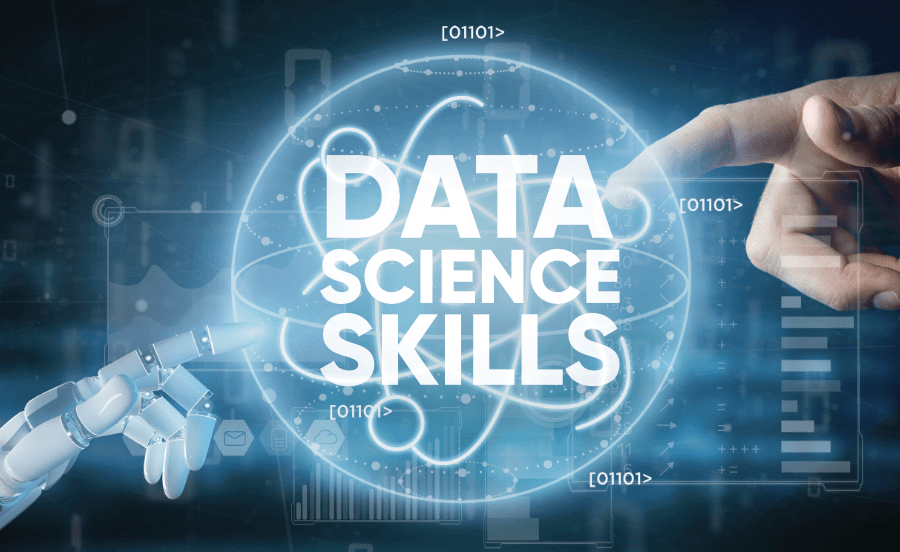Nearly ten years after Harvard Business Review declared data science the “sexiest job of the 21st century,” it remains an excellent career choice. According to the Bureau of Labor Statistics, the median salary for a data scientist is $122,840, and the field is expected to grow much faster than average over the next decade.
As a content creator at Dataquest, an online data science education platform, I’ve seen how becoming a data scientist can transform lives. Through countless conversations with learners, data scientists, and hiring managers, I’ve learned what it takes to succeed in this field and which skills make candidates stand out.

Before diving into those skills, two key points about applying for data science jobs:
First, “data science” is a broad term, and job requirements can vary widely. Titles like “data scientist” or “data analyst” may mean different things at different companies—some might call the same role “machine learning engineer.” So, cast a wide net when job hunting and read descriptions carefully. Searching by skills rather than just job titles can help.
Second, the golden rule of job hunting: employers want proof you can do the job. This is especially true in data science, where there’s no universally recognized credential. If you lack experience, you’ll need a portfolio of projects showcasing your skills.
These projects could be from school, personal work, or a mix. Highlight the most relevant ones on your resume and make sure they’re accessible via GitHub. (Don’t know GitHub yet? Don’t worry—we’ll get to that.)
To land a data science role, focus on mastering these seven in-demand skills—and demonstrating them in your applications.
1. Programming
You can’t avoid it—coding is essential for data science. Specifically, you’ll need Python or R, the two most common languages in the field.
The good news? You don’t need both. Python is more popular in business, while R dominates academia. Either is fine, but if you choose Python, pick resources focused on data science—generic courses may waste time on irrelevant topics.
Once you’ve picked a language, learn key libraries (pre-written tools that simplify coding). In Python, focus on numpy, pandas, matplotlib, and scikit-learn. In R, the tidyverse is essential.
Workflow skills like Git/GitHub (for version control and collaboration) are a must. UNIX command line knowledge isn’t mandatory but helps with efficiency, cloud data work, and automation.
How to Develop This Skill
Interactive platforms like Dataquest or Codecademy (where you write real code) are ideal. Video courses (Coursera, EdX, YouTube) work too—just ensure they’re data science-focused.
How to Demonstrate It
List programming languages in your resume’s skills section, but also showcase clean, well-commented code in GitHub projects. Expect coding tests in interviews—either live coding, take-home tasks, or whiteboard challenges.
2. SQL
SQL (pronounced “S-Q-L” or “sequel”) is a query language for retrieving data from databases. It’s older and less flashy than machine learning, but it’s critical—most companies store data in SQL databases. In 2020, data professionals used SQL more than Python or R!
How to Develop This Skill
Mode Analytics offers a free SQL tutorial. Most data science platforms also teach SQL.
How to Demonstrate It
Include SQL projects on GitHub. Brush up before interviews—you might be quizzed on joins or asked to write queries.
3. Handling Messy Data
This covers two skills:
- Data cleaning: Fixing formatting, typos, duplicates, etc., using code (not manual spreadsheet work).
- Unstructured data: Processing raw data (like social media streams) into usable formats.
How to Develop This Skill
Practice with dirty datasets. Try projects using Twitter API data—it’s unstructured but well-documented.
How to Demonstrate It
On your resume, describe cleaning steps for projects. Example:
“Filtered tweet data via Twitter API, cleaned with regex, and tokenized for sentiment analysis.”
4. Machine Learning / “AI”
Exciting but complex! You don’t need to know everything—just master popular algorithms like:
- Linear/logistic regression
- Naive Bayes
- Decision trees (CART, random forests)
- Clustering (k-means, PCA)
Specialize further if targeting specific roles (e.g., NLP for speech recognition).
How to Develop This Skill
Learn by doing—Kaggle competitions are great practice.
How to Demonstrate It
Showcase ML projects on your resume. Example:
“Predicted home prices with 97% accuracy using a KNN model.”
5. Communication
Often overlooked but crucial. Your analysis is useless if others can’t understand it.
- Data visualization: Make clear, impactful charts (avoid misleading clutter).
- Writing/speaking: Explain findings to technical and non-technical audiences.
How to Develop This Skill
Practice explaining projects to non-technical friends. Study data viz design principles.
How to Demonstrate It
Use Jupyter notebooks (mix code, visuals, and explanations). Keep GitHub projects well-documented. In interviews, articulate your process clearly.
6. Critical Thinking & Problem Solving
Data scientists must identify valuable insights—not just execute tasks. Ask: What impacts the business?
How to Develop This Skill
Research companies and brainstorm data-driven solutions (even if you don’t build them).
How to Demonstrate It
Tailor projects to target companies. Example: Analyze a retailer’s sales data to suggest improvements. In interviews, ask insightful questions about their data challenges.
7. Statistics
The foundation of data science. You don’t need a PhD, but grasp:
- Probability
- Sampling methods
- Hypothesis testing
How to Develop This Skill
Take stats courses (Khan Academy is great) or learn via data science platforms.
How to Demonstrate It
Explain statistical choices in project notebooks. Example:
“Used stratified sampling to ensure subgroup representation.”

